Rectangle MNOP is shown on the graph below.
If the rectangle were translated 2 units down, what would be the coordinates of P’?
 A. (–5, –1)
A. (–5, –1)
B. (–1, –5)
 C. (1, 5)
C. (1, 5)
 D. (5, 1)
D. (5, 1)
 A. (–5, –1)
A. (–5, –1)
Triangle JKL will be reflected across the y-axis.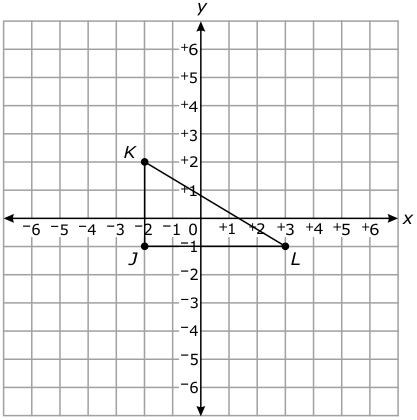
What will be the coordinates of J′?
 A. (–2, 1)
A. (–2, 1)
B. (2, –1)
 C. (–1, 2)
C. (–1, 2)
 D. (1, –2)
D. (1, –2)
(2, -1)
Square JKLM is shown on the graph below.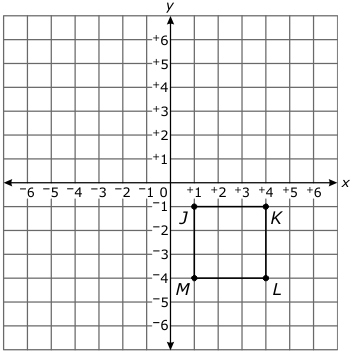
If the square is rotated 180° clockwise about the origin, what will be the coordinates of K′?
 A. (–4, –1)
A. (–4, –1)
 B. (–1, –4)
B. (–1, –4)
 C. (–1, 4)
C. (–1, 4)
D. (–4, 1)
(-4, 1)
Two figures are shown below. 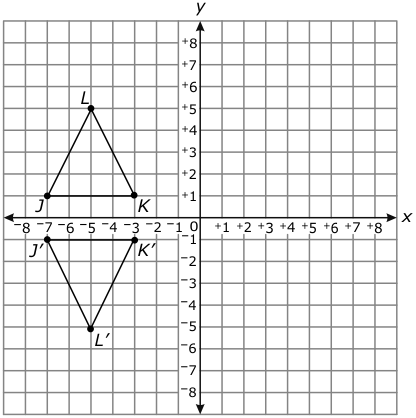
Which statement is true?
A. △J′K′L′ is a reflection of △JKL over the x-axis.
 B. △J′K′L′ is a reflection of △JKL over the y-axis.
B. △J′K′L′ is a reflection of △JKL over the y-axis.
 C. △J′K′L′ is a translation of △JKL four units down.
C. △J′K′L′ is a translation of △JKL four units down.
 D. △J′K′L′ is a rotation of △JKL 90° counterclockwise.
D. △J′K′L′ is a rotation of △JKL 90° counterclockwise.
A. △J′K′L′ is a reflection of △JKL over the x-axis.
Square RSTU will be translated 4 units to the right and 4 units up.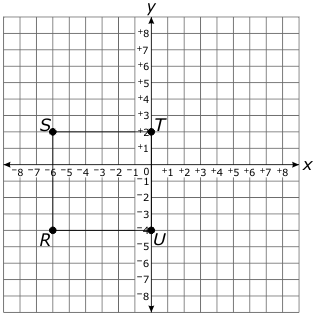
What will be the coordinates of U′?
 A. (−4, 0)
A. (−4, 0)
 B. (0, 0)
B. (0, 0)
 C. (0, 4)
C. (0, 4)
D. (4, 0)
(4, 0)
Triangle PQR was reflected across the y-axis resulting in the triangle below.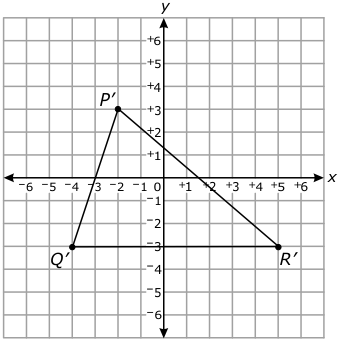
What were the coordinates of pre-image point Q?
 A. (–4, 3)
A. (–4, 3)
 B. (–3, 4)
B. (–3, 4)
 C. (3, –4)
C. (3, –4)
D. (4, –3)
(4, -3)
Triangle EFG will be rotated 90° counterclockwise about the origin.
What are the vertices of triangle E′F′G′?
A. E′(–2, –1), F′(–5, 2), G′(–2, 3)
 B. E′(–1, –2), F′(2, –5), G′(3, –2)
B. E′(–1, –2), F′(2, –5), G′(3, –2)
 C. E′(1, –2), F′(–2, –5), G′(–3, –2)
C. E′(1, –2), F′(–2, –5), G′(–3, –2)
 D. E′(2, 1), F′(5, –2), G′(2, –3)
D. E′(2, 1), F′(5, –2), G′(2, –3)
A. E′(–2, –1), F′(–5, 2), G′(–2, 3)
Quadrilateral MNOP will be reflected over the y-axis then rotated 90° counterclockwise.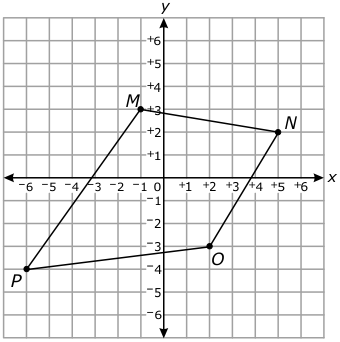
What will be the coordinates of N′?
 A. (2, 5)
A. (2, 5)
 B. (5, 2)
B. (5, 2)
 C. (-5, 2)
C. (-5, 2)
D. (-2, -5)
D. (-2, -5)
28
Multiple Choice from Item Bank
Rectangle WXYZ is graphed below.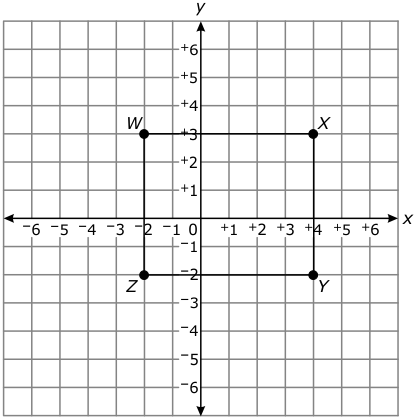
If the rectangle is translated 6 units to the left and 3 units up, what will be the coordinates of Y′?
 A. (–2, –5)
A. (–2, –5)
B. (–2, 1)
 C. (10, –5)
C. (10, –5)
 D. (10, 1)
D. (10, 1)
(-2, 1)
The quadrilateral graphed below will be reflected over the x-axis.
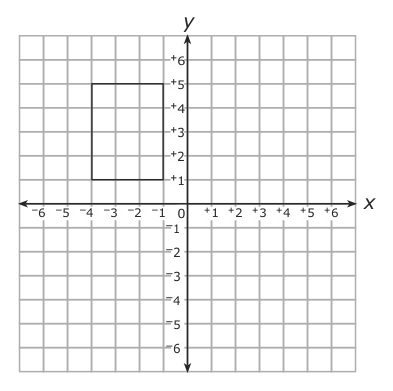
What will be the coordinates of the vertices of the image quadrilateral?
 A. (4, –1), (1, –1), (1, 5), (4, –5)
A. (4, –1), (1, –1), (1, 5), (4, –5)
 B. (1, 1), (1, 5), (4, 1), (4, 5)
B. (1, 1), (1, 5), (4, 1), (4, 5)
 C. (–1, 4), (–1, 1), (–5, 1), (–5, 4)
C. (–1, 4), (–1, 1), (–5, 1), (–5, 4)
D. (–4, –1), (–4, –5), (–1, –5), (–1, –1)
D. (–4, –1), (–4, –5), (–1, –5), (–1, –1)
Trapezoid QRST is graphed below.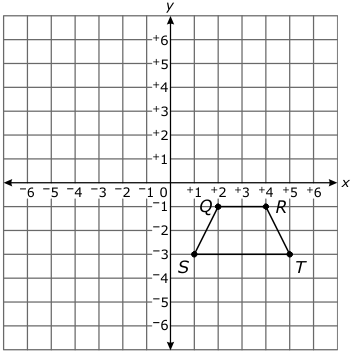
If the trapezoid is rotated 270° clockwise about the origin, what will be the coordinates of R′?
 A (4, 1)
A (4, 1)
B (1, 4)
 C (–1, –4)
C (–1, –4)
 D (–4, –1)
D (–4, –1)
(1, 4)
The triangle shown will be reflected over the y-axis and then reflected over the x-axis.

Which transformation will produce the same image?
A. rotating the triangle 180° about the origin
B. rotating the triangle 360° about the origin
C. translating the triangle 4 units up and 10 units to the right
D. translating the triangle 10 units up and 10 units to the right
A. rotating the triangle 180° about the origin
Quadrilateral RSTU will be translated 4 units right and 3 units up.
What will be the coordinates of the image point R' after the translation?
(-2,-1)
Rectangle PQRS has side lengths of 7 and 3 as shown on the grid below.

Rectangle PQRS is reflected across the y-axis to form Rectangle P'Q'R'S' What is the length of line segment Q'R'?
A. 3
B. 6
C. 7
D. 14
3
The graph below shows triangle L′M′N′, after a 90° counterclockwise rotation about the origin.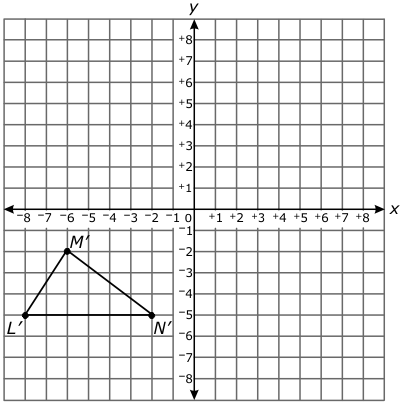
What were the coordinates of pre-image point L?
 A. (–8, 5)
A. (–8, 5)
B. (–5, 8)
C. (5, –8)
 D. (8, –5)
D. (8, –5)
(-5, 8)
Triangle EFG is graphed below.
If the triangle is translated 4 units to the right and 3 units down, then reflected over the x-axis, what will be the coordinates of G′?
A. (3, 2)
B. (3, -4)
 C. (2, 3)
C. (2, 3)
 D. (2, 2)
D. (2, 2)
A. (3, 2)
Figure WXYZ is shown below.

Figure WXYZ is translated up 3 units and 4 units to the right to create Figure W'X'Y'Z'. What is the measure of angle Z' after this transformation?
A 103°
B 96°
C 77°
D 58°
103°
This graph shows parallelogram JKLM.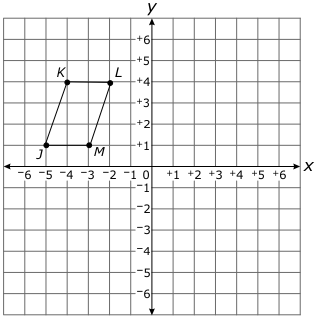
When JKLM is reflected across the y-axis, what will be the coordinates of the vertices of the image parallelogram?
A. J′(5, 1), K′(4, 4), L′(2, 4), M′(3, 1)
B. J′(5, –1), K′(4, –4), L′(2, –4), M′(3, –1)
C. J′(1, 5), K′(4, 4), L′(4, 2), M′(1, 3)
D. J′(–5, –1), K′(–4, –4), L′(–2, –4), M′(–3, –1)
A. J′(5, 1), K′(4, 4), L′(2, 4), M′(3, 1)
Triangle MNP has angles of 89°, 46°, and 45° as shown in the figure below.

Triangle MNP is rotated 90° clockwise about the origin to form Triangle M'N'P'. What is the measure of ![]()

A. 44°
B. 45°
C. 46°
D. 89°
46°
Quadrilateral PQRS is rotated 90° counterclockwise about the origin and then translated 6 units to the right to form Quadrilateral ZWXY.

What segment has the same length as ![]()

A. ![]()
 B.
B. ![]()
 C.
C. ![]()
D. ![]()
D. ![]()